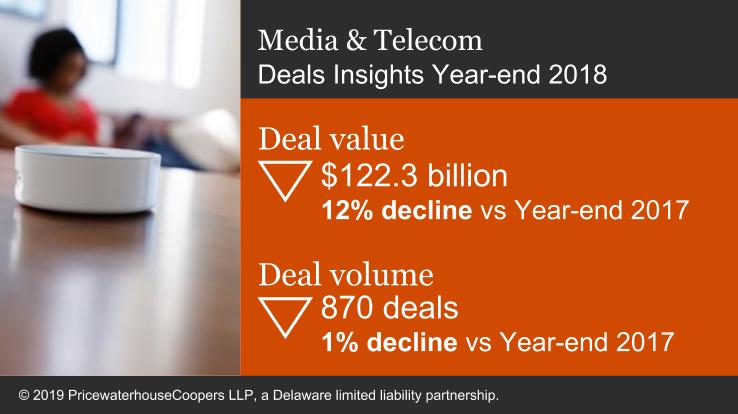Next Wave of Convergence to Drive M&A: PwC

The next wave of convergence is expected to drive merger and acquisition activity in 2019, according to a new report from PwC.
Companies in the U.S. media and telecom sector will be looking to obtain direct-to-consumer capabilities, PwC said. Also driving deals will be the emergence of super-competitors and demand for data and artificial intelligence.
“2019 will represent a historic inflection point in the media & telecom sector, as several vertically integrated players look to finalize their transformational deals and launch service offerings--such as OTT platforms that go direct to consumer--aimed at competing with the established SVOD players and disrupting the traditional business models,” said Bart Spiegel, U.S. technology, media and telecommunications deals partner at PwC.
In the fourth quarter of 2018, the number of deals dropped by 6% to 172 from a year ago, while the value of those deals dropped 74% to $20.8 billion. For the full year, deal volume fell 1% to 870, while their value declined 12% to $122.3 billion.

There were 18 deals greater than $1 billion in value announced ruing 2018, including T-Mobile buying Sprint for $27.8 billion, Altice USA being bought by shareholders for $10.5 billion and Nexstar Media buying Tribune Media for $6.4 billion.
PwC identified four trends that will drive M&A in 2019 and create new waves in the media and telecom sector:
- The next wave of convergence: Over the last few years, we have seen the once thick border that separated the traditional Technology and Media players in this space dissolve. Companies have integrated both vertically and horizontally. Many of the distinctions that had once defined a company’s strategy (print vs. digital, video games vs. sports, pay-TV vs. over-the-top) are now not so clear. The upside to all this change? Companies are no longer burdened by these narrow definitions and can look across the field and outside of their comfort zone for potential acquisition targets that create space and opportunity for new revenue streams, greater positioning in the value chain, and more relevant scale.
- Get me that consumer, now: We know that consumers and their devices are always on. For years the focus was on providing an ever-expanding supply and diversity of content and then enhancing the consumer experience and overall engagement. With quality content and experience under their belt, it’s no surprise that many players have shifted their focus to building a relationship directly with the consumer, tapping into the value of their fanbase. We expect that companies will be looking to not only bolster their content offerings, but also to seek out incremental capabilities to enhance their ability to deliver digitally and directly to consumers.
- The rise of supercompetitors: With the growing pace of convergence comes the emergence of supercompetitors: global players with similar businesses that when knitted together cover much of the entire TMT ecosystem (from content, to technology, to advertising and distribution) under a single corporate roof with an abundance of resources. We expect this deep-pocketed class of market participants to continue to make big plays in content, investments in startups, and serve as buyers for maturing businesses. We also predict many other players may assume they have no choice but to follow suit.
- More data, more AI: Those who have it, have the upper hand. Access to data and analytics (“D&A”) and the use of artificial intelligence is not only important in supporting better decision making, but is vital in the battle to own the consumer and thus more of the digital value chain. It allows companies to not only build but also measure consumer engagement and satisfaction – driving efficiencies in monetization and increasing relevance to consumers.
The smarter way to stay on top of broadcasting and cable industry. Sign up below
Jon has been business editor of Broadcasting+Cable since 2010. He focuses on revenue-generating activities, including advertising and distribution, as well as executive intrigue and merger and acquisition activity. Just about any story is fair game, if a dollar sign can make its way into the article. Before B+C, Jon covered the industry for TVWeek, Cable World, Electronic Media, Advertising Age and The New York Post. A native New Yorker, Jon is hiding in plain sight in the suburbs of Chicago.

